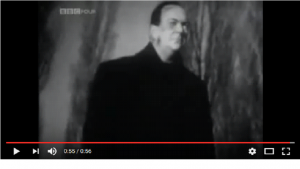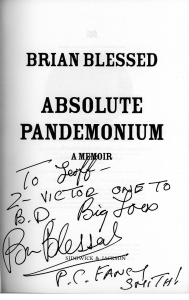Following a discussion on the use of the Eidophor projector (see Slides, Slide Mounts and Slide Scanners for TV – was Eidophor used on “Z-Cars”? Dave Plowman noted that he didn’t remember Eidophor being used for “Z-Cars”, saying that the only reason to use Eidophor was to handle an electronic picture, and the BP was film. Dave Mundy remembers a very large film projector and very large mirror being used for BP.
John Howell (Hibou)
Eidophor for BP seems most unlikely. There would have to be a VT play-in machine located in the basement with comms to the Production Gallery and , probably, the Eidophor operator in the studio. This would have been a big deal in the early days of VT when it was known as “Ampex”.
Also, as has been pointed out, the Eidophor machine would have been unacceptably noisy and could not be powered down and re-started quickly.
Dave Mundy
remembers a very large film projector and very large mirror being used for BP.
Roger Bunce
Very large projector, with steam (?) coming out the top, and a very large mirror, indeed. The projector may be seen in the background of the attached still from “Paul Temple”.
(Click on the picture below to see a larger or clearer version of this picture:
Click the “X” button (top right) to close the newly opened picture.)
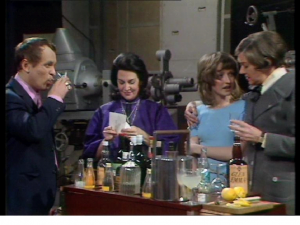
You’ve conjured memories of a young, slightly hippy, camera assistant called Peter Langford, who was trying to master the art of the yo-yo. He found a dark corner of the “Z Cars” studio, in which he could practice, unobserved. Then the projector fired up – and BP screen was filled with a hugely enlarged silhouette of Peter and his yo-yo!
On another occasion, the same Peter bought a plastic police helmet, truncheon and whistle set, from Woolworths, and brought it into the studio. It was immediately grabbed by the cast. For the rest of rehearsals, whenever a policeman appeared in a doorway, he would be wearing the helmet, swinging the truncheon, and talking through the whistle.
Graeme Wall
Ah! the bottle of Glen Emma in foreground!
Alasdair Lawrance
Was the ’steam’ the exhaust of an arc?
John Howell
The projector in the background is the ‘stills’ machine, the moving images projector would be even bigger in an enormous blimp, and yes, smoke from the arc lamps, I wonder if they had FOUR projectors, two still and two moving; side and rear backing? Come to think of it wasn’t there a loud ‘screech’ when the arcs were struck?
I never worked on a “Z-Cars” but I imagine a ‘stop and get out’ sequence would be something like this:
Frontal 2-shot, moving BP seen through the rear window,
Cut to:
Single shot of driver with minimal or no BP in view,
Grams plays ‘down through the gears and stop with brakes squeak’
BPs go to still projectors.
Cut to:
Action with side and rear BP stills on the screens.
No? OK how did it work?
Mike Minchin
As I remember, from doing several months of live 50 minute Z’s in ?1962, there were indeed two blimped “movie” projectors, with, if needed, parallel “still” projectors, each pair working through large mirrors onto BP screens, so that head-on and side shots of the car could be taken. I was never involved with the scenario where the actors had “leap out of a moving car”, though. The projectors all had arcs (hence the “steam” coming from the top), and the operators needed to chose their moment as to when to strike the arc – it was noisy. I also seem to remember that the blimping wasn’t that sound proof, and you could hear the film mechanism running up – but doubtless the Sound Crew had ways of getting round that. As I remember, the BP boys worked from scripts for their cues, and were not specifically cued by the “secretary”, though I am also sure they had a feed of talk-back.
Peter Hider
BP was in constant use on “Z Cars” and brings to mind two specific incidents.
Cut from TK insert of car driving along road to Studio Z Victor 1 (The half a Ford Zephyr with no windscreen on a boat truck) driven by Fancy Smith in daylight. BP film cue was given too early and runs out before the dialogue does and it goes very dark outside the car. Fancy says “It gets dark quickly this time of year.”
The second memorable occasion was when the following scene in the pub wasn’t ready. As the actors move to get out of the car the director tells them through the floor manager to get back into the car and run the scene again, which they did, giving the viewers a sense of deja vue. The happy days of, seat of the pants, live television. I am fairly sure that this sort of incident happened fairly regularly as the likes of Hugh Sheppard, Gordon Blockley and Ken Major will attest.
Roger Bunce
(Click on the picture below to see a larger or clearer version of this picture:
Click the “X” button (top right) to close the newly opened picture.)
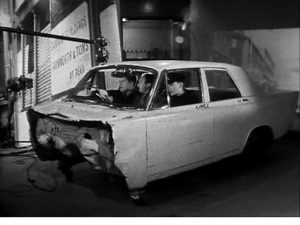
Watching “Z Cars” at home, when I was a teenager – I remember once seeing the street scene suddenly disappear from the rear window of the Z Car, to be replaced by a flashing “10 – 9 – 8 etc.” film countdown. On another occasion P. C. Lynch was riding in the passenger seat. The dialogue had reached the point where the car should have stopped so that he could step out. But the back-projected scenery was still travelling past at speed. As he opened the door, Jimmy Ellis improvised the desperate line, “Don’t bother to stop. I’ll jump for it!”
Working on it, as a very junior Cameraman – I remember one difficult shot which I particularly needed to rehearse. It started with a close-up of P. C. Bannerman (Paul Angelis) inside the Z Car. He was watching out for a suspect. With a sudden cry of, “There he goes!” he would leap out of the car and give chase. My camera had to crane up and track backwards rapidly, in order to cover his movement, taking care not to get hit by the opening door. Such was the speed and abruptness of the move that it was difficult enough for a sprog like me to keep the actor in frame and focus. But there was an added complication in that the studio Z Car was just the sawn-off middle section of a car. As I hurtled backwards and my shot widened I had to ensure that only the believable parts of the Z Car were visible in the background. Timing and positions were critical, both for the camera and the actor. I had had problems with the shot during early rehearsals. Now it was the final run-through – my last chance to get it right before recording. I set up the opening of the shot, my lens poking through the side window of the Z Car. I braced myself ready for a rapid pull back as the door was thrown open. Tension mounted as the dialogue cue approached. It came. “There he goes!” cried P. C. Bannerman but, instead of flinging open the door, he pointed dramatically ahead, his arm extending through the glassless windscreen. Then, with remarkable agility, his leg followed his arm, and he stepped straight forward, through the windscreen! So, I never did get my final rehearsal.
(Apologies to everyone I’ve already bored rigid with that story!)
Nick Ware
Another famous one was ZV1 (half car in front of BP) driving along at 40mph or so, supposed to be timed to slow down and stop on cue by the end of the dialogue, grams doing the gear changes and slow-down fx on the PEG (remember that?). But BP kept going and the gear sounds didn’t happen, so whichever cop driving looks over his shoulder at the BP and shouts “Jump!”. T’other cop did jump, massively over-acting, much to everyone’s delight.
Pat Heigham
Oh! I remember PEG (Programme Effects Generator) – for the benefit of our vision colleagues, this was an audio gadget which was designed to play in sound effects, having a bank of four play units and one recording bay. It used matchbox sized cassettes of 1/4″ tape, having a loop at the end to be picked up by the loading mechanism. One of the units was the recording unit which would put a locating pulse on the front of the tape to position the tape at the start of the recorded sound. It had a very fast start, making it possible to accurately cue in effects. The maximum play time of a cassette was about 30 secs.
I found it quite a useful machine, as during a play in TC7, I was able to keep a WW1 battle going, with shell firing, shell whistles and explosions perfectly timed in between actors’ dialogue. Nowadays, I guess this can all come from an audio programme off computer!
Dave Plowman
I don’t think the police would have used Zodiacs as patrol cars. They were the same mechanically as the Zephyr, but better trim (more chrome) and perhaps two tone paint. A sort of early Ghia or whatever.
Many car makers at this time produced a special police version. Perhaps heavy duty suspension and better brakes. But rarely more power – although bar room pundits often said they had.
“Z Cars” ran long enough to get through more than one model range. I think it may have been 3, Mk2-4 The Zephyr 4 was the four cylinder version, previously called the Consul. And if you’re not confused now, I am.
The Zephyr model name died out with the Mk4, later large Fords becoming Granadas.
I discussed this with my big brother. He’s pretty certain the early “Z Car” episodes used Mk2 Zephyrs too, with the Mk3 only being introduced by Ford in mid 1062. He had a Zephyr around that time so more likely to remember than me. I wonder if the opening titles from the first episodes are still around, being film?
(Click on the pictures below to see a larger or clearer version of the picture:
Click the “X” button (top right) to close the newly opened picture.)
(from “Z Cars” title sequence, first episode:)
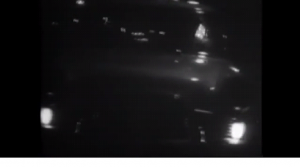
(from “Z Cars” title sequence, 1963:)
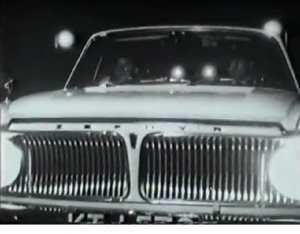
John Bennett
There’s lots of “Z Cars” clips on YouTube.
Hugh Sheppard
Oh, the tricks the memory plays: not only the first episode of “Z-Cars” but also “People’s Property” of 15 May 1962 (courtesy of YouTube) featured Mk. II Ford Zephyrs, plus John Watt’s Ford Angular! And nary a frontal shot of the famous mock-ups + BP in the studio. With so much on film, these early episodes. are almost a social history of Merseyside.
Given time off for good behaviour, I might trace when the switch to Mk. IIIs happened. The switch could probably be most readily picked up from the closing credits.
David Brunt
The “Z Cars” episode “People’s Property” was John McGrath’s pet project. He wrote and directed it so it ended up being mostly on film location in Liverpool with only about ten pages of script to be performed live in studio, the complete opposite to the usual episodes. Filming didn’t get to Liverpool very often after that.
This episode “Made For Each Other” (1963) has a good BP car scene around 43’00” in:
https://www.youtube.com/watch?v=gLYrZP9bpEI
(Click on the picture below to see a larger or clearer version of this picture:
Click the “X” button (top right) to close the newly opened picture.)
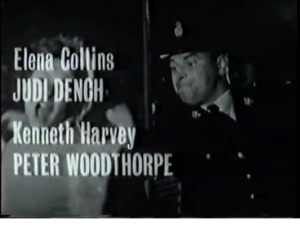
Ian Hillson
“For police use Ford fitted the slightly larger Zodiac engine into the Zephyr 6 body shell” it says here: http://www.oldclassiccar.co.uk/police-fords.htm – for lots of pics just Google “Zephyr Zodiac police patrol cars.”
The above is quite an interesting site , by the way, because you can check if a vehicle in a drama is of the correct age here: http://www.oldclassiccar.co.uk/registrations/reg-letters.htm up until 1973 when Cardiff took over issuing them from local authorities. Take the data with a pinch of salt though – for instance, my police minivan NLX***L registered in Nov 1972 isn’t shown – the last entry being MLX***L in Sept 1972.
If you ever buy an old police car you’ll find a zip in the headlining under where the blue light sat. Police in panda cars used to keep their sandwiches in this space!
Geoff Fletcher
I did a fair number of “Z Cars”. The cars were Zephyrs certainly in the early years. Some times there were two BP Projectors in the studio with their accompanying huge BP mirrors. They had chimney like vents on top emitting grey fumes that often looked blue and I found the damn things quite scary as I came to the BBC from GEC where we tested oil filled transformers – hot oil wasn’t nice stuff to be around.
If you want a good read about “Z Cars”, try Brian Blessed’s highly entertaining book “Absolute Pandemonium”. There is a very good chapter about his “Z Cars” days as PC Fancy Smith. There is also a photo of him and Jock Weir standing by their Zephyr patrol car.
(Click on the picture below to see a larger or clearer version of this picture:
Click the “X” button (top right) to close the newly opened picture.)
Brian describes one event in his book when an elderly actor got out of the car he was “driving” when it was still “travelling” at an apparent 50 mph according to the BP behind the shot!
Also – didn’t somebody track a mole backwards into a BP mirror with dire (as regards the mirror – mercifully not the Dolly Op) and noisy consequences? Pete Hills was the TM and allegedly came on talkback with the immortal comment “Christ! That’s f****d it Squire!” Or am I confusing Tales Of Old Television here? Or is this one of the good old BBCTV myths?
see also More Personalities – the Talent
Hugh Sheppard
Historians of “Z-Cars” would say that ‘Z’ was the designation of a mythical Merseyside division, with little or nothing to do with the Z of Ford Zephyrs.
The original cars – speaking as one who worked on Ep.1, no doubt alongside Ken Major and Gordon Blockley and …. my memory says that the cars were initially Ford Zephyr 6 Mk IIIs for which Ford lists production as starting in 1962. As Z’s began in January 1962 this must have attracted car-buffs, with 2 studio mock-ups, or rather prototype mid-body sections from the factory, and real cars for all the filming. Even the door-handles weren’t real, but had a shiny, flexible plastic skin over a rigid former.
I lasted through the infamous 100th episode. in 1964, unusually directed by producer David Rose, but which needed so many retakes to make the telerecording presentable that they were abandoned, until around no. 130, by which time I had risen from dolly-op. 1 to No. 3 cameraman, albeit interrupted by a PA attachment to Pres. The real break-through of the series was thanks to David and a score of superb directors, including John McGrath, Herbie Wise, John Moxey, Robin Midgely, Shaun Sutton, Rudy Cartier and, memorably, Ken Loach. Many came to Z’s thanks to a long-running ITV strike and brought with them a trust in the studio crew previously missing from many BBC trained directors. With the best, if a scene didn’t work in rehearsal, the FM – for a long time Edward Ballard – or perhaps a cameraman, could suggest a way to revise it and be asked to show how from the gallery. Unheard of according to BBC rules at that time. Even the TOM, Sam Neeter, started to take pride in the give and take.
Halcyon days.
Graeme Wall
I thought I’d worked on the last “Z Cars” but apparently I’m wrong as I’d left the BBC a year earlier. I remember an end shot with the metal blinds being pulled down over the station windows, cut to an exterior shot of a concrete building in an otherwise desolate waste-land. This would have been in the first half of 1977. Anyone know what it was?
<Thinks> Could it have been the last Dixon?
David Brunt
There were no “Z Cars” recordings in 1977. That year’s season was made over the summer of 1976 and left on the shelf for about nine months. The final season recorded January – June 1978, all on OB.
Dixon ended in 1976, as did “Softly Softly”. It doesn’t sound like the final episodes of either.
Geoff Fletcher
Here is a “Z Cars” photo – originally from Mike Cotton (see http://tech-ops.co.uk/next/z-cars/) for the 100th episode in March 1964.
I took the liberty of giving it a bit of a tidy up tweak in Photoshop.
(Click on the picture below to see a larger or clearer version of this picture:
Click the “X” button (top right) to close the newly opened picture.)

Dave Mundy
After the end of the 60 min. episodes Z’s returned as two live (?) 30 min. episodes each week and were some of the most fraught shows I ever did on grams! One particular writer was a masochist towards Gram Ops! The worst episode was called ‘Car-to-Car’ which was set almost entirely in ZV1 and ZV2 and required different background effects for each car plus other spot effects. Luckily, the Leevers-Rich tape machines had a switch to change the output so that I could change fx when the vision mixer cut between cars. Another episode was set in a block of council flats, on a high floor, so that the lift kept arriving, the milkman delivered glass bottles, dogs barked, aircraft passed over, you get the picture! I wish I could have met him! After all that, successfully transmitted, I was told that I hadn’t been selected to be a Gram Op. because I didn’t go to the bar enough! I put that to rights when I transferred to OBs!
Geoff Hawkes
…and to add to the mix, here’s a couple of the pics I took of a BP machine and car on the successor to “Z Cars”, “Softly Softly”, circa 1971:
(Click on the pictures below to see a larger or clearer version of the picture:
Click the “X” button (top right) to close the newly opened picture.)
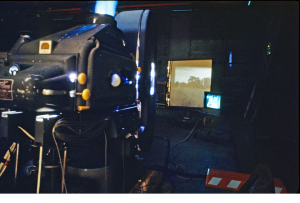
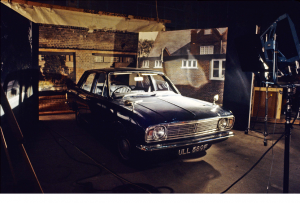
Tony Crake
Well that looks like a 1968 Cortina. Good picture of the BP Machine.
John Howell
Cracking pictures – you even caught the aforementioned ‘steam’ (smoke) coming from the projector arc!
Alec Bray
“Z-Cars” Titles. Interesting shadow appears. I’m sure, of course, it must be a branch of the tree!
(Click on the picture below to see a larger or clearer version of this picture:
Click the “X” button (top right) to close the newly opened picture.)
